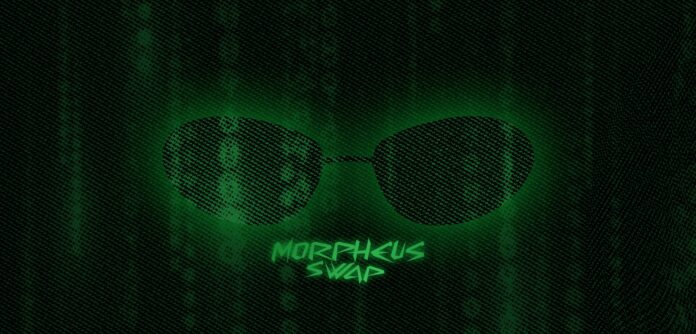Morpheus Swap is a farming and aggregator platform on Fantom that aims to deliver profitability, safety, and stability in a decentralized ecosystem.
Fantom currently ranks as the world’s 7th largest decentralized finance (DeFi) platform in terms of total value locked (TVL), a feat that secures its place as one of the most trusted web3 protocols. The study, spearheaded by DefiLlama, the biggest TVL aggregator for DeFi projects, believes that TVL, alongside other factors, is one of the most critical indicators of a robust DeFi network. Fantom’s constant effort to improve its DeFi services will not only secure its ranking in the competition but would directly benefit the decentralized applications (dApps) and users within its ecosystem.
Table of Contents
Background
Morpheus Swap, which borrows its theme from the ‘Matrix’ movie, bases its DeFi goal on the famous ‘Red Pill’ analogy, which involves choosing an unsettling yet life-changing truth. This symbolism is the complete opposite of taking the ‘Blue Pill’, which means the willingness to choose comfort and ignorance. The name ‘Morpheus’ is also based on one of Matrix’s central characters, who handed out the red and blue pills to Neo, the movie’s protagonist, and made him choose between the two options.
What is Morpheus Swap?
Morpheus Swap is a farming and aggregator platform on the Fantom Protocol that promises profitability, safety, and stability. In using the platform, users must utilize the MetaMask wallet and despite only supporting Ethereum, Morpheus will initiate a configuration to connect them to the Fantom Opera Network. The Morpheus team aims to turn the project into a 100% decentralized system to provide users with more secure services and compete better with other yield farming projects.
Fantom: A Refresher
Fantom Protocol is a Proof-of-Stake (PoS) layer-1 platform specifically designed to deliver fast, affordable, scalable, and eco-friendly transactions. Its other capabilities include absolute finality, an average 1-second transaction, independent transaction validation, and robust security to distributed networks. With these game-changing features, dApps can seamlessly execute their full potential and gain protection from network congestion and skyrocketing fees that can directly affect their services.
MORPH Token
$MORPH Token is Morpheus Swaps’ emission token, which currently has limited information and updates on the protocol’s website. Right now, it has an unlimited supply, with 85% allocated to emissions for farms/pools, 15% to the Treasury, and 10% to the team.
PILLS Token
$PILLS, the project’s governance token, is the only authorized token on the Neo Pools, the platform’s very own pools. Users can mint this token by burning MORPH tokens and all the emission tokens used in the process will undergo burning, permanently eliminating them.
MORPH and PILLS’ ratio begins at 1:1, and five days after launch, it will go up by0.30 every 30 days. In other words, while the emitted MORPH is continuous, fewer PILLS can be minted every 30 days because of the decrease in ratio.
Another important reminder is that PILLS is a ‘one-way’ token, meaning users cannot convert them back to MORPH. The team believes that this two-token model will help Morpheus produce increased value for users and maintain its longevity in the competition.
Neo Pools
Neo Pools is where investors can stake their farmed MORPH tokens, and aside from dividend pools, Morpheus also aims to offer “partnership pools” to allow users to earn tokens outside its ecosystem. The pools provide a consistent per-second transfer of rewards and have countdown timers to give stakers exact details regarding the pools’ expiration
Morpheus’ pools are easy to use and only require two short steps: First is to approve a pool, and second, stake the preferred MORPH amount. Once the pool turns active, stakers can start receiving their rewards and may increase their stakes to generate more income.
Upcoming Implementations
Geofencing Proposal (Approved)
The IP-based geofencing proposal, which garnered 67.53% approval from the community, was finally passed last May 26, 2022, and will soon be implemented by the Morpheus team. According to this proposal, an IP-based geofencing that can block United States users will be suitable for the Morpheus Swap to reduce the risk of U.S. regulatory policies hitting its core operations.
With lessons learned from the recent lawsuit filed against Uniswap by two U.S. law firms, and the government’s slow management of web3-related cases like that of XRP and LBRY, geofencing can offer clear protection for the platform. But the team has reminded users that while the proposal is already approved, there will be no drastic changes in the network as the transition will be gradual.
mLDQR Liquid Staking (Proposed)
The proposal, posted last June 2, 2022, suggests a new feature called “mLQDR Liquid Staking,” which will allow users to gain xLQDR rewards while keeping their capability to trade their mLQDR position. According to the proposal, its mechanism can enhance the platform’s influence on the Liquidity Driver protocol and benefit Morpheus’ Swap Pools.
LQDR is the primary token of Liquid Driver, the first-ever liquidity mining dApp on the Fantom protocol, (xLQDR and mLQDR are two variations of its tokens) It also allows users to stake their L.P. tokens and provide liquidity on other Fantom-based networks such as SpookySwap, WakaFinance, and SpiritSwap, to earn LQDR tokens.
Conclusion
Morpheus Swap has all the basic capabilities that one would expect in a DeFi platform, and it’s interesting to know that its newest feature was proposed and approved by its community. Another advantage the project has is the Fantom Protocol, one of today’s most promising blockchain networks, giving the DeFi project a solid foundation in offering efficient web3 services.
